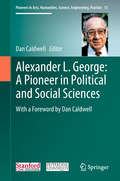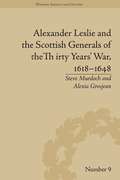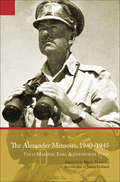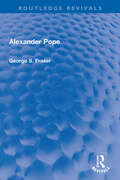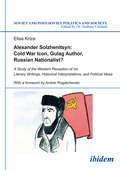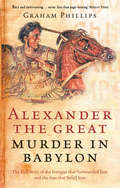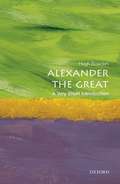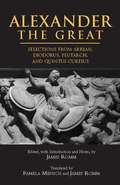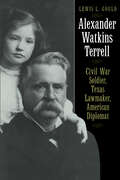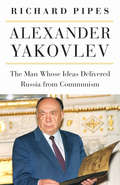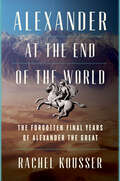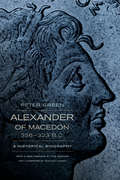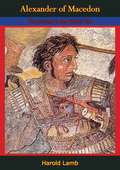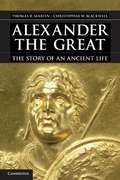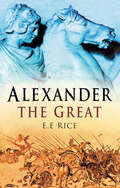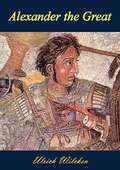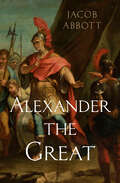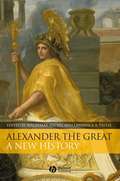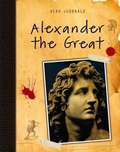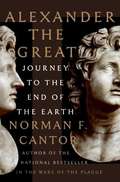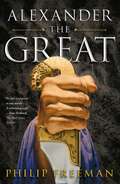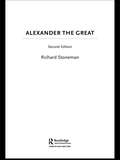- Table View
- List View
Alexander L. George: With a Foreword by Dan Caldwell (Pioneers in Arts, Humanities, Science, Engineering, Practice #15)
by Dan CaldwellAlexander L. George was one of the most productive and respected political scientistsof the late twentieth century. He and his wife, Juliette George, wrote one of the firstpsychobiographies, and Professor George went on to write seminal articles and booksfocusing on political psychology, the operational code, foreign policy decisionmaking,case study methodology, deterrence, coercive diplomacy, policy legitimacy, and bridgingthe gap between the academic and policymaking communities. This book is the firstand only one to contain examples of the works across these fields written by AlexanderGeorge and several of his collaborators.• This is a collection of Alexander L. George's works from the major fields to whichhe contributed.• There are biographical essays by his wife and co-author (Juliette L. George), daughter(Mary George Douglass), former student (Dan Caldwell), and professional colleague(Janice Gross Stein).• There are 25 photographs of Alexander L. George and his family which have notpreviously been published.
Alexander Leslie and the Scottish Generals of the Thirty Years' War, 1618–1648 (Warfare, Society and Culture #9)
by Alexia Grosjean Steve MurdochField Marshal Alexander Leslie was the highest ranking commander from the British Isles to serve in the Thirty Years’ War. Though Leslie’s life provides the thread that runs through this work, the authors use his story to explore the impacts of the Thirty Years’ War, the British Civil Wars and the age of Military Revolution.
Alexander Memoirs, 1940–1945
by Alexander of TunisAfter his first meeting with General Alexander in August 1942, Lieutenant-General Sir Brian Horrocks wrote that: By repute he was Winston Churchills fire brigade chief par excellence: the man who was always dispatched to retrieve the most desperate situations.Churchill was indeed in need of a fire brigade chief. Allied forces had been chased back across the desert by Rommel. Alexander bought a new hope to the Desert Rats: he instilled them with his own confidence and thought of victory. Under his command, Montgomery was ready to fight and win the battle of El Alamein. Even as his generals drove the enemy from North Africa, Alexander was planning far ahead for Sicily and Operation Husky: the first major seaborne invasion by either side during the war.It was said that before El Alamein the Allies never knew victory, and after El Alamein never knew defeat: much of the credit belongs to Alexander. For decades his contribution to the British efforts in both wars has been overlooked. Here, however, is a comprehensive edition of his personal and candid memoirs, which includes judgments on such men as Montgomery, Patton and Churchill. He also details his role in leading the withdrawal of the 1st Infantry Division at Dunkirk, his dealings with Stilwell in Burma and the bombing of the Monte Cassino abbey.
Alexander Pope (Routledge Revivals)
by G.S. FraserFirst published in 1978, Alexander Pope is an introduction to Pope’s life and work, which sets the poet solidly in his age and relates the liveliness and variety of his poetry to the strange combination of chronic invalidism and a sociable disposition which marked his life. G. S. Fraser argues that Pope is a more varied figure than his reputation as a great satirist indicates and that he is in some ways more a survivor from the Restoration than a precursor of middle-class morality. Special attention is paid to the poems in the first Collected Works of 1717, which displays both Pope’s gaiety and his sense of colour and beauty. The dignity of his translation of Homer and the thoughtfulness and piety of An Essay on Man are also emphasised. His satirical genius, which found its greatest expression during the later years of declining health, is not ignored but set in perspective. Many readers of this persuasively argued study will be surprised to discover in it a gayer, more warm-hearted and more likeable Pope than they had, perhaps, imagined. Students of English literature will find this book immensely refreshing.
Alexander Solzhenitsyn: A Study of His Western Reception (Soviet and Post-Soviet Politics and Society #131)
by Elisa KrizaThis book offers an in-depth analysis of Alexander Solzhenitsyn's reception in the U.S., U.K., and Germany before and after 1991. Elisa Kriza explores his corpus through the paradigm of witness literature and confronts contentious subjects, such as antifeminism, anti-Semitism, and revisionism. Redefining Solzhenitsyn's work as memory culture, Kriza reveals the dynamics that transform a controversial figure into a moral icon.
Alexander Solzhenitsyn: Cold War Icon, Gulag Author, Russian Nationalist?
by Elisa KrizaAlexander Solzhenitsyn was one of the Cold War's most iconic writers. This book offers an in-depth analysis of his reception in the US, UK, and Germany before and after 1991. Elisa Kriza skillfully explores how Solzhenitsyn's work can be understood with the paradigm of witness literature and uncovers the dynamics behind the politicized reception of his writing. From the mid-1980s onwards, Solzhenitsyn's popularity dwindled--was this for ideological reasons? What about the rumors linking him with Russian nationalism? This study does not shy away from stretching beyond anti-communism and touching more contentious subjects--such as anti-feminism, anti-Semitism, and revisionism--in Solzhenitsyn's work and reception. Bringing Solzhenitsyn back from his 'critical exile' and redefining his work as memory culture, Kriza's book is a crucial scholarly intervention, unveiling the mechanism that can transform a controversial figure into a moral icon.
Alexander The Great
by Graham PhillipsMURDER IN BABYLON is a real-life historical detective story: a true tale of murder and mystery that has remained untold for over two thousand years.Recreating the scene of the crime to reveal eight suspects, each with the motive and opportunity to have assassinated the king. Graham Phillips uncovers a maze of intrigue, power-play and romantic tragedy that led inevitably towards Alexander's death. Ultimately, in a dramatic twist in the tale, the murderer is finally unveiled.
Alexander The Great: A Very Short Introduction
by Hugh BowdenAlexander the Great became king of Macedon in 336 BC, when he was only 20 years old, and died at the age of 32, twelve years later. During his reign he conquered the Achaemenid Persian Empire, the largest empire that had ever existed, leading his army from Greece to Pakistan, and from theLibyan desert to the steppes of Central Asia. His meteoric career, as leader of an alliance of Greek cities, Pharaoh of Egypt, and King of Persia, had a profound effect on the world he moved through. Even in his lifetime his achievements became legendary and in the centuries that followed his storywas told and retold throughout Europe and the East. Greek became the language of power in the Eastern Mediterranean and much of the Near East, as powerful Macedonian dynasts carved up Alexander's empire into kingdoms of their own, underlaying the flourishing Hellenistic civilization that emergedafter his death. But what do we really know about Alexander? In this Very Short Introduction, Hugh Bowden goes behind the usual historical accounts of Alexander's life and career. Instead, he focuses on the evidence from Alexander's own time - letters from officials in Afghanistan, Babylonian diaries, records fromEgyptian temples - to try and understand how Alexander appeared to those who encountered him. In doing so he also demonstrates the profound influence the legends of his life have had on our historical understanding and the controversy they continue to generate worldwide.
Alexander The Great: Selections from Arrian, Diodorus, Plutarch, and Quintus Curtius
by James Romm Pamela MenschComprising relevant selections from the four ancient writers whose portraits of Alexander the Great still survive--Arrian, Diodorus, Plutarch, and Quintus Curtius--this volume provides a complete narrative of the important events in Alexander's life. The Introduction sets these works in historical context, stretching from the conclusion of the Peloponnesian War through Alexander's conquest of Asia, and provides an assessment of Alexander's historical importance as well as a survey of the central controversies surrounding his personality, aims and intentions. This edition includes a timeline, maps, a bibliography, a glossary, and an index.
Alexander Watkins Terrell: Civil War Soldier, Texas Lawmaker, American Diplomat (Focus on American History Series)
by Lewis L. GouldAlexander Terrell's career placed him at the center of some of the most pivotal events in nineteenth- and early twentieth-century history, ranging from the Civil War to Emperor Maximilian's reign over Mexico and an Armenian genocide under the Ottoman Empire. Alexander Watkins Terrell at last provides the first complete biographical portrait of this complex figure. Born in Virginia in 1827, Terrell moved to Texas in 1852, rising to the rank of Confederate brigadier general when the Civil War erupted. Afterwards, he briefly served in Maximilian's army before returning to Texas, where he was elected to four terms in the state Senate and three terms in the House. President Grover Cleveland appointed him minister to the Ottoman Empire, dispatching him to Turkey and the Middle East for four years while the issues surrounding the existence of Christians in a Muslim empire stoked violent confrontations there. His other accomplishments included writing legislation that created the Texas Railroad Commission and what became the Permanent University Fund (the cornerstone of the University of Texas's multibillion-dollar endowment). In this balanced exploration of Terrell's life, Gould also examines Terrell's views on race, the impact of the charges of cowardice in the Civil War that dogged him, and his spiritual searching beyond the established religions of his time. In his rich and varied life, Alexander Watkins Terrell experienced aspects of nineteenth-century Texas and American history whose effects have continued down to the present day.
Alexander Yakovlev: The Man Whose Ideas Delivered Russia from Communism (NIU Series in Slavic, East European, and Eurasian Studies)
by Richard PipesA significant political figure in twentieth-century Russia, Alexander Yakovlev was the intellectual force behind the processes of perestroika (reconstruction) and glasnost (openness) that liberated the Soviet Union and Eastern Europe from Communist rule between 1989 and 1991. Yet, until now, not a single full-scale biography has been devoted to him. In his study of the unsung hero, Richard Pipes seeks to rectify this lacuna and give Yakovlev his historical due. Yakovlev's life provides a unique instance of a leading figure in the Soviet government who evolved from a dedicated Communist and Stalinist into an equally ardent foe of everything the Leninist-Stalinist regime stood for. He quit government service in 1991 and lived until 2005, becoming toward the end of his life a classical western liberal who shared none of the traditional Russian values. Pipes's illuminating study consists of two parts: a biography of Yakovlev and Pipes's translation of two important articles by Yakovlev. It will appeal to specialists and students of Soviet and post-Soviet studies, government officials involved with foreign policy, and general readers interested in the history of Russia and the Soviet Union.
Alexander at the End of the World: The Forgotten Final Years of Alexander the Great
by Rachel Kousser“A heart-pounding, mind-bending adventure.” —Ilyon WooA riveting biography of Alexander the Great’s final years, when the leader’s insatiable desire to conquer the world set him off on an exhilarating, harrowing journey that would define his legacy. By 330 B.C.E., Alexander the Great had reached the pinnacle of success. Or so it seemed. He had defeated the Persian ruler Darius III and seized the capital city of Persepolis. His exhausted and traumatized soldiers were ready to return home to Macedonia. Yet Alexander had other plans. He was determined to continue heading east to Afghanistan in search of his ultimate goal: to reach the end of the world. Alexander’s unrelenting desire to press on resulted in a perilous seven-year journey through the unknown eastern borderlands of the Persian empire that would test the great conqueror’s physical and mental limits. He faced challenges from the natural world, moving through deadly monsoons and extreme temperatures; from a rotating cast of well-matched adversaries, who conspired against him at every turn; and even from his own men, who questioned his motives and distrusted the very beliefs on which Alexander built his empire. This incredible sweep of time, culminating with his death in 323 BC at the age of 32, would come to determine Alexander’s legacy and shape the empire he left behind. In Alexander at the End of the World, renowned classicist and art history professor Rachel Kousser vividly brings to life Alexander’s labyrinthine, treacherous final years, weaving together a brilliant series of epic battles, stunning landscapes, and nearly insurmountable obstacles. Meticulously researched and grippingly written, Kousser’s narrative is an unforgettable tale of daring and adventure, an inspiring portrait of grit and ambition, and a powerful meditation on the ability to learn from failure.
Alexander of Macedon, 356-323 B.C.: A Historical Biography
by Peter GreenUntil recently, popular biographers and most scholars viewed Alexander the Great as a genius with a plan, a romantic figure pursuing his vision of a united world. His dream was at times characterized as a benevolent interest in the brotherhood of man, sometimes as a brute interest in the exercise of power. Green, a Cambridge-trained classicist who is also a novelist, portrays Alexander as both a complex personality and a single-minded general, a man capable of such diverse expediencies as patricide or the massacre of civilians. Green describes his Alexander as "not only the most brilliant (and ambitious) field commander in history, but also supremely indifferent to all those administrative excellences and idealistic yearnings foisted upon him by later generations, especially those who found the conqueror, tout court, a little hard upon their liberal sensibilities." This biography begins not with one of the universally known incidents of Alexander's life, but with an account of his father, Philip of Macedonia, whose many-territoried empire was the first on the continent of Europe to have an effectively centralized government and military. What Philip and Macedonia had to offer, Alexander made his own, but Philip and Macedonia also made Alexander form an important context for understanding Alexander himself. Yet his origins and training do not fully explain the man. After he was named hegemon of the Hellenic League, many philosophers came to congratulate Alexander, but one was conspicuous by his absence: Diogenes the Cynic, an ascetic who lived in a clay tub. Piqued and curious, Alexander himself visited the philosopher, who, when asked if there was anything Alexander could do for him, made the famous reply, "Don't stand between me and the sun." Alexander's courtiers jeered, but Alexander silenced them: "If I were not Alexander, I would be Diogenes." This remark was as unexpected in Alexander as it would be in a modern leader. For the general reader, the book, redolent with gritty details and fully aware of Alexander's darker side, offers a gripping tale of Alexander's career. Full backnotes, fourteen maps, and chronological and genealogical tables serve readers with more specialized interests.
Alexander of Macedon, 356–323 B.C.
by Peter GreenUntil recently, popular biographers and most scholars viewed Alexander the Great as a genius with a plan, a romantic figure pursuing his vision of a united world. His dream was at times characterized as a benevolent interest in the brotherhood of man, sometimes as a brute interest in the exercise of power. Green, a Cambridge-trained classicist who is also a novelist, portrays Alexander as both a complex personality and a single-minded general, a man capable of such diverse expediencies as patricide or the massacre of civilians. Green describes his Alexander as "not only the most brilliant (and ambitious) field commander in history, but also supremely indifferent to all those administrative excellences and idealistic yearnings foisted upon him by later generations, especially those who found the conqueror, tout court, a little hard upon their liberal sensibilities."This biography begins not with one of the universally known incidents of Alexander's life, but with an account of his father, Philip of Macedonia, whose many-territoried empire was the first on the continent of Europe to have an effectively centralized government and military. What Philip and Macedonia had to offer, Alexander made his own, but Philip and Macedonia also made Alexander form an important context for understanding Alexander himself. Yet his origins and training do not fully explain the man. After he was named hegemon of the Hellenic League, many philosophers came to congratulate Alexander, but one was conspicuous by his absence: Diogenes the Cynic, an ascetic who lived in a clay tub. Piqued and curious, Alexander himself visited the philosopher, who, when asked if there was anything Alexander could do for him, made the famous reply, "Don't stand between me and the sun." Alexander's courtiers jeered, but Alexander silenced them: "If I were not Alexander, I would be Diogenes." This remark was as unexpected in Alexander as it would be in a modern leader.For the general reader, the book, redolent with gritty details and fully aware of Alexander's darker side, offers a gripping tale of Alexander's career. Full backnotes, fourteen maps, and chronological and genealogical tables serve readers with more specialized interests.
Alexander of Macedon: The Journey to the World’s End
by Harold LambTHE STORY OF THE GREATEST MILITARY GENIUS OF ALL TIME—ALEXANDER THE GREATFrom the dark forests of barbarian Europe, across the illimitable steppes of Asia, into the cities of golden India—Alexander led his invincible Macedonians to conquer the world.Harold Lamb, the superb historian-storyteller—whose brilliant Genghis Khan, Suleiman the Magnificent and Tamerlane have been read by millions—brings to pulsing life the story of a man who towered above his age, conquered the world, and forever changed the tide of human destiny.
Alexander the Glorious
by Jane OliverIn ALEXANDER THE GLORIOUS, Jane Oliver takes as her subject that thirteenth-century Alexander who brought a golden age of order to the chaos and violence that marked medieval Scotland. His story is that of the evolution of a frightened and lonely boy into a wise and just ruler. Crowned king when he was only seven, forced into a marriage with Margaret--daughter of Henry III of England--while they were still children, and considered by his elders as little more than a pawn in their own quest for power, he successfully resisted the intrigues of both his father-in-law and his lords to usurp his prerogatives. As social and military leader of his people, he raised them to great heights and found his reward in the satisfaction of seeing his child bride grow into a loving, and beloved, wife and mother. But if his middle years were full of joy, his later years were doomed to personal tragedy. Just when he should have been able to enjoy the fruits of his labors, he was forced into an ill-fated second marriage in order to provide a new heir to the throne. Only in the light of this period, during which Edward I of England was already casting a covetous eye upon Scotland, can the long years of darkness that would overtake Alexander's people upon his death be properly understood, years that would see his nation placed under an English rule that would not end until the emergence of Wallace and Bruce.
Alexander the Great
by Christopher W. Blackwell Thomas R. MartinEverything we know about Alexander comes from ancient sources, which agree unanimously that he was extraordinary and greater than everyday mortals. From his birth into a hypercompetitive world of royal women through his training under the eyes and fists of stern soldiers and the piercing intellect of Aristotle; through friendships, rivalries, conquests and negotiations; through acts of generosity and acts of murder, this book explains who Alexander was, what motivated him, where he succeeded (in his own eyes) and where he failed, and how he believed that he earned a new 'mixed' nature combining the human and the divine. This book explains what made Alexander 'Great' according to the people and expectations of his time and place and rejects modern judgments asserted on the basis of an implicit moral superiority to antiquity.
Alexander the Great
by E E RiceKing Alexander III 'the Great' of Macedon was one of the greatest military commanders the world has ever known. This book seeks to dispel some of the myths which have grown up around him and to provide an up-to-date account of his life. This includes the Macedonian background and Alexander's early years, his campaigns in Thrace and Illyria and the destruction of Thebes, the invasion of the Persian Empire and the battles which led to its conquest, his expeditions to India and finally his death in Babylon. Dr Rice also assesses Alexander's personality, and provides a summary of his legacy to the western world.
Alexander the Great
by Ulrich Wilcken G. C. Richards"ALEXANDER THE GREAT opened a new era in the history of the world, and by his life's work determined its development for many centuries. He is conspicuous among the great men of history, because this work was accomplished in so short a span; when he died, he had not yet reached his thirty-third year. It was as a great conqueror that he impressed the popular imagination of every race. He subdued the East and penetrated into India, that land of wonders. The legend about him, equally current in East and West, took him to the limits of the earth and even to the gates of Paradise. The permanent result of his life, however, was not the empire which he won by hard fighting, but the development of Greek civilisation into a civilisation which was worldwide. It is in this way that his influence has affected the history of mankind even down to our own time. He had first to create his empire; the decision of the battlefield had, as usual, to produce the external conditions for the new civilisation."Originally published in 1932, Ulrich Wilcken's distinguished biography of Alexander the Great is widely regarded as a classic, perfectly capturing Alexander's true achievements and influence.Translated from German by G. C. Richards, Professor of Greek and Classical Literature at Oriel College, Oxford University.
Alexander the Great
by Jacob AbbottA complete biography of the ancient Macedonian king and one of history&’s greatest military leaders.Alexander the Great, son of King Philip II of Macedonia, and his fourth wife, Olympias, seemed destined for success. He had Aristotle for a tutor until he was sixteen. He took interest in his father&’s military efforts abroad, and worried there would be nothing left to conquer when he became king. When ambassadors from Persia arrived in Macedonia, they tried to entertain young Alexander with colorful stories of their home, but the future leader was more interested in their armies and war tactics. It should be no surprise that Alexander became one of ancient history&’s greatest and most successful military leaders.In this biography, author Jacob Abbott recounts the life and times of Alexander the Great. He takes readers through the king&’s early years, including his youth and education, as well as his relationship with his parents. The history continues with Alexander&’s ascension to the throne at the age of twenty and details all the drama and military victories over the next ten years of the monarch&’s reign as he expanded his empire from Macedonia and Egypt to northwest India. Unfortunately, Alexander&’s demise soon followed, but not before he left his mark on the world. Nineteenth-century American author Jacob Abbott wrote many books over the course of his own life from juvenile fiction to history. He wrote numerous biographies on such monumental individuals as Alfred the Great, Queen Elizabeth I, Genghis Khan, Julius Caesar, and Peter the Great.
Alexander the Great
by Waldemar Heckel Lawrence A. TritleAlexander the Great: A New History combines traditional scholarship with contemporary research to offer an innovative treatment of one of history's most famous figures.Written by leading experts in the fieldLooks at a wide range of diverse topics including Alexander's religious views, his entourage during his campaign East, his sexuality, the influence of his legacy, and his representations in art and cinemaDiscusses Alexander's influence, from his impact on his contemporaries to his portrayals in recent Hollywood filmsA highly informed and enjoyable resource for students and interested general readers
Alexander the Great
by Nick HunterKnow all about ancient Greece, the rise of Alexander to power, his victories, failures and what happened after his death.
Alexander the Great
by Norman Cantor"Alexander's behavior was conditioned along certain lines -- heroism, courage, strength, superstition, bisexuality, intoxication, cruelty. He bestrode Europe and Asia like a supernatural figure." In this succinct portrait of Alexander the Great, distinguished scholar and historian Norman Cantor illuminates the personal life and military conquests of this most legendary of men. Cantor draws from the major writings of Alexander's contemporaries combined with the most recent psychological and cultural studies to show Alexander as he was -- a great figure in the ancient world whose puzzling personality greatly fueled his military accomplishments. He describes Alexander's ambiguous relationship with his father, Philip II of Macedon; his oedipal involvement with his mother, the Albanian princess Olympias; and his bisexuality. He traces Alexander's attempts to bridge the East and West, the Greek and Persian worlds, using Achilles, hero of the Trojan War, as his model. Finally, Cantor explores Alexander's view of himself in relation to the pagan gods of Greece and Egypt. More than a biography, Norman Cantor's Alexander the Great is a psychological rendering of a man of his time.
Alexander the Great
by Philip FreemanIn the first authoritative biography of Alexander the Great written for a general audience in a generation, classicist and historian Philip Freeman tells the remarkable life of the great conqueror. The celebrated Macedonian king has been one of the most enduring figures in history. He was a general of such skill and renown that for two thousand years other great leaders studied his strategy and tactics, from Hannibal to Napoleon, with countless more in between. He flashed across the sky of history like a comet, glowing brightly and burning out quickly: crowned at age nineteen, dead by thirty-two. He established the greatest empire of the ancient world; Greek coins and statues are found as far east as Afghanistan. Our interest in him has never faded. Alexander was born into the royal family of Macedonia, the kingdom that would soon rule over Greece. Tutored as a boy by Aristotle, Alexander had an inquisitive mind that would serve him well when he faced formidable obstacles during his military campaigns. Shortly after taking command of the army, he launched an invasion of the Persian empire, and continued his conquests as far south as the deserts of Egypt and as far east as the mountains of present-day Pakistan and the plains of India. Alexander spent nearly all his adult life away from his homeland, and he and his men helped spread the Greek language throughout western Asia, where it would become the lingua franca of the ancient world. Within a short time after Alexander&’s death in Baghdad, his empire began to fracture. Best known among his successors are the Ptolemies of Egypt, whose empire lasted until Cleopatra. In his lively and authoritative biography of Alexander, classical scholar and historian Philip Freeman describes Alexander&’s astonishing achievements and provides insight into the mercurial character of the great conqueror. Alexander could be petty and magnanimous, cruel and merciful, impulsive and farsighted. Above all, he was ferociously, intensely competitive and could not tolerate losing—which he rarely did. As Freeman explains, without Alexander, the influence of Greece on the ancient world would surely not have been as great as it was, even if his motivation was not to spread Greek culture for beneficial purposes but instead to unify his empire. Only a handful of people have influenced history as Alexander did, which is why he continues to fascinate us.
Alexander the Great
by Richard StonemanAlexander the Great by Richard Stoneman is an introduction to the career and impact of the great Macedonian conqueror and the main themes of his reign. As well as tackling problems of interpretation, the author includes: an examination of the written and other sources and the problems of working with them discussion of archaeological and numismatic evidence an outline of the Macedonian background insight into Alexander's education and ideas exploration of Alexander's claim to divinity assessment of Alexander's short and long-term achievements a study of his influence in antiquity.
